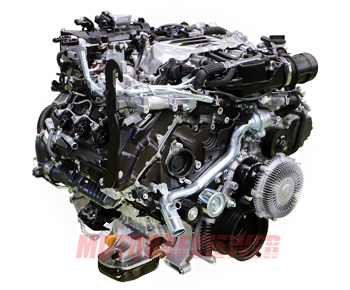Toyota F33A-FTV 3.3L Engine Specs, Problems, Reliability, Info

Toyota 3.3L Diesel F33A-FTV Info
The 3.3-liter twin-turbo V6 diesel engine, called F33A-FTV, was first introduced in 2021 as a new power option for the Toyota Land Cruiser 300 (a year later it also became available for the Lexus LX 500d). Interesting fact: the F33A-FTV is the first V6 diesel engine produced by Toyota. The new diesel engine has replaced the 4.5-liter V8 1VD-FTV. Meanwhile, both of them have the same bore and stroke, and a 90-degree angle between cylinder banks. So let's take an in-depth look at the design of F33A-FTV, its features, pros/cons, and reliability.
3.3L F33A-FTV Engine Features
The F33A-FTV is built around a closed-deck type, cast iron cylinder block. As mentioned above, the engine has some similarities with the previous V8 diesel engine, the 1VD-FTV. As mentioned above, the engine has some similarities with the previous V8 diesel engine, the 1VD-FTV. The new V6 diesel engine has the same bore and stroke, and the angle between the cylinder banks is also 90 degrees (this is unusual for V6 engines). The F33A block features a carbon steel crankshaft, high-strength steel connecting rods (they are diagonally split), and steel pistons with DLC coating. The oil sump consists of two parts: an upper aluminum part and a steel sump at the bottom. On top of the block, there are aluminum DOHC cylinder heads with 4 valves per cylinder. The heads feature integrated and water-cooled exhaust manifolds. Valves are actuated using roller rocker arms that are equipped with valve lash adjusters. The engine uses chains for timing: one primary roller chain and two secondary chains.
Fuel system: Common Rail system by Denso, branded as intelligent-Accuracy Refinement Technology or i-ART. It comes with HP5D injection pump (32-270 MPa) and electromagnetic type injectors. On the exhaust side, there is a pair of variable geometry turbochargers. Two modes are available: single-turbo mode and twin-turbo mode. The intake system is equipped with a liquid-type intercooler. It is connected to the second cooling circuit, which also cools both turbochargers, AdBlue supply module, and exhaust fuel injector. The main cooling circuit is meant for engine cooling only. It features a regular belt-driven pump, a conventional thermostat, and a fan with electro-viscous clutch. The second cooling system comes with a brushless electric pump.
Emission Control Systems
The 3.3L F33A-FTV engine can be equipped with a range of emission control systems: EGR, EGR+DOC, EGR+DPF, EGR+SCR+DPF. What is their purpose? The EGR is an exhaust gas recirculation system. DOC — oxidation catalyst. DPF is a diesel particulate filter, used to eliminate soot particles. The SCR, or selective catalytic reduction, is a system that injects AdBlue/DEF fluid (consumption is up to 2 liters per 1000 km).
Engine Specs
Oil recommendations and capacity may vary depending on the car model, year, and market. Please check the service manual specific to your vehicle!
The Most Common 3.3L F33A-FTV Problems
The engine is still new to the market, but there is always a possibility of something going on in the future. To date, no serious problems have been found. However, this engine is not ideal.
While the internal components seem to be well-designed, the emission systems always cause issues. Some owners have experienced problems with the DPF regeneration process due to fuel injector failure. Some engines consume motor oil from the first miles. A thin 0W-20 oil is more likely the reason for this (it is good for efficiency, but not for long-term use). The next source of complaints is the SCR system. It adds extra cost to running a vehicle and is known for its reliability issues.
F33A-FTV Reliability and Longevity
Is the 3.3-liter V6 twin-turbo diesel a good, reliable engine? By modern standards, it is. The F33A-FTV have no issue with the internal parts, but it is stuffed with emission systems. This emission complexity is the main source of troubles for many modern diesel engines. The average lifespan of the 3.3L F33A-FTV is not yet known for sure, but some owners have reported reaching over 200,000 miles of use without any issues. To prolong the life of this engine, it's important to follow a maintenance schedule and always use good fuel and oil.
